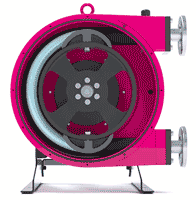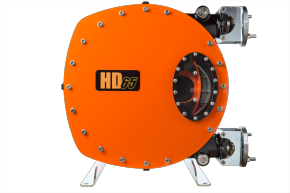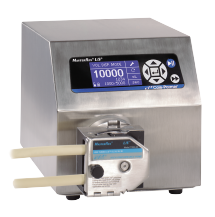A peristaltic pump works by pressure and displacement. It is used mainly to pump liquids, yet even with solids, through a hose or tube. Hence no parts of the pump come into a contact with the pumped liquid.



Peristaltic Pumps
43 series from 7 manufacturers
-
- Acetate
- Adhesives
- Agriculture
- Bakery and confectionery
- Beauty & Personal Care
- Brewing and beverages
- Building Services
- Ceramics
- Chemical
- Convenience food
- Dairy
- Detergents
- Distilleries
- Docks
- Drinking Water
- Dye & Pigment
- Electronics
- Emulsions
- Fertilizers
- Fish Farming
- Food & Beverage
- Fruit Concentrates
- Heating, Water & Sanitation
- Marine
- Meat Processing
- Medical Hospitals
- Mining
- Oil & Gas
- Oil Fats & Mayonnaise
- Paint & Surface Coating
- Paints & Resins
- Paper Mills
- Pet Food
- Petrochemical
- Pharmaceutical
- Plastic
- Power Generation
- Research & Development
- Sugar Processing
- Surface Finishing
- Swimming Pools & Spas
- Textile
- Wastewater
- Water Treatment
-
- Analysis
- Booster
- Circulation
- Cleaning
- Control
- Conveying
- Cooling
- Descaling
- Desinfection
- Dewatering
- Diagnostic
- Discharge
- Distribution
- Dosing
- Drain
- Drainage
- Dual Dispensing
- Extraction
- Feed
- Filling
- Filtration
- Flow Control
- Greasing
- Grinding
- Handling
- Heating
- High-Pressure
- High-Temperature
- High-Volume
- Injection
- Irrigation
- Level Control
- Lift
- Lifting
- Loading
- Low-Pressure
- Lubrication
- Medium-Pressure
- Metering
- Mixing
- Off-loading
- Powder Coating
- Pressurisation
- Process
- Processing
- Recirculation
- Recovery
- Refueling
- Replacement
- Rinsing
- Sampling
- Settling
- Spraying
- Tempering
- Transfer
- Treatment
- Unloading
- Volumetric Dispensing
- Washing
- Water-Jet Cleaning
-
- Abrasive Liquids
- Acetate
- Acids
- Adhesives
- Alcohols
- Aluminium Oxide Slurry
- Ammonia
- Beer
- Biological Broths and Slurries
- Bitumen
- Carbon Fibers
- Caustic Solutions
- Cereals
- China Clay Slurry
- Chocolate
- CIP Fluids
- Clay
- Coffee
- Concrete
- Cooling Water
- Corrosive Dyes
- Corrosive Liquids
- Crystalline Slurry
- Dairy Products
- Detergents
- Diesel Fuel Oil
- Drinking Water
- Dye Pigment
- Emulsions
- Ethylene Glycol
- Ferric Chloride
- Fertilizers
- Foam Protein
- Fruit and Vegetables
- Fruit Concentrates
- Gels
- Glycol
- High Temperature Oils
- High Viscosity Liquids
- Hydrochloric Acid
- Hygienic Liquids
- Irrigation Water
- Lake Water
- Latex
- Light Fluids
- Lime
- Liquid CO2
- Low NPSH
- Low Viscosity Liquids
- LPG
- Meat
- Milk
- Molasses and Syrups
- Must
- Non-Newtonian Fluids
- Oil, Fats and Mayonnaise
- Paints
- Paints Resins
- Personal Care Products
- Pet Food
- Phosphoric Acid
- Plastic
- Process Condensate
- Produced Water
- Radio Active Fluids
- Redox
- Refrigerants
- Rubber
- Sauces
- Seawater
- Sensitive and Viscous Fluids
- Separated Oil Processing
- Sewage
- Silver Nitrate
- Soaps and Detergents
- Solids and Abrasives
- Solvents
- Spirits
- Sulphuric Acids
- Surface Water
- Surfactants
- Synthetic Fibers
- Thermal Oil
- Thin Liquids
- Thixotropic Fluids
- Toluene
- Toxic Liquids
- Ultra Pure Water
- Vegetable Oils
- Vinegar
- Viscose
- Viscous Liquids
- Wastewater
- Water
- Water Hardness
- Wine
- Wort
-
- Abrasion Resistant
- Adjustable-Flow
- Automatic
- Booster Sets
- Chemically Resistant
- CIP
- Close-Coupled
- Compact
- Corrosion-Proof
- Direct-Drive
- Double-Acting
- Electric
- Explosion-Proof
- Fish Friendly
- Flange
- Heavy-Duty
- High Temperature
- High-Efficiency
- High-Performance
- Horizontal Mount
- Hygienic
- In-Line
- Intrinsically Safe
- Low Shear
- Low-Noise
- Mechanical
- Mixed Flow
- Mobile
- Modular
- Motorless
- Non-Metal
- Oil-Free
- Pneumatic
- Pulse-less
- Rotary
- Rugged
- Sanitary
- Seal-less
- Self-priming
- Single-Stage
- SIP
- Solids Handling
- Variable Speed
Do you need help finding the right pump that meets your needs?
We have experienced experts who are ready to help you!
Get in touch hereHOW DOES A PERISTALTIC PUMP WORK?
Peristaltic pumps work according to the peristaltic principle. The hose, as the central component in the pump, is compressed by sliding shoes or rollers that are attached to a rotor and moved over the hose. The pinched spot moves along the tube, and the contained liquid is pushed forward. After compression, the restoring forces of the high-strength hose ensure that it opens back into its original shape. This creates a strong negative pressure, which supplies more liquid from the line.
In high-pressure hose pumps in particular, the rotor is exposed to heavy loads.
Peristaltic pumps are a pre-training pump and work according to the peristaltic principle. The hose, which can consist of a variety of materials, is paced in the pump housing. The pump rotor exerts pressure when it rotates on a set of rollers or pressure jaws which, in turn, compress the hose. This creates a vacuum behind the roller or pressure jaw that sucks in liquid in the hose while the next roller or pressure jaw gently pushes the liquid forward through the hose.The only wear part of the pump is the hose which can be quickly and economically replaced on site.
The hose, as the central component of the pump, is compressed by pressure jaws or rollers attached to a rotor and moved over the hose. The pinched spot moves along the tube and the entrapped liquid is pushed forward. After compression, restorative forces from the high-strength hose ensure that it opens back to its original shape. This creates a strong negative pressure, which adds more fluid from the pipe.
Especially in high-pressure hose pumps, the rotor is exposed to large loads. Some peristaltic pumps have a lifetime warranty on the rotor. Peristaltic pumps with an integrated rotor bearing significantly reduce the mechanical stress on the gear unit and the motor, which ensures a longer service life.

WHAT DIFFERENT KINDS OF PERISTALTIC PUMPS ARE THERE?
With peristaltic pumps, the compression of the hose can be achieved by rollers or shoes. Quantity and dosing determines the type.
Roller peristaltic pumps are usually more advantageous when dosing smaller quantities or at lower pressure levels. For higher dosing quantities or at higher working pressures, sliding shoe hose pumps work more efficiently and are more gentle on the hose.
IN WHICH APPLICATIONS ARE PERISTALTIC PUMPS USED?
- Peristaltic pumps are the first choice for metering and pumping liquids in many different industries.
- Some peristaltic pumps can meter abrasive liquid mixtures such as milk of lime, ferric chloride and other flocculants in water treatment plants.
- High-pressure hose pumps are used to feed filter presses in sewage treatment plants in order to dewater the sewage sludge.
- Peristaltic pumps with hygiene certification meter colorants, flavors, dairy products and shear-sensitive media in food production.
THE CORRECT SIZING OF PERISTALTIC PUMPS
In addition to the size, the right selection of components determines efficiency, safety and service life. An even, constant flow rate is achieved by pulsation dampers. This protects the pipelines and all upstream and downstream components of the system. The restoring forces of the hose are supported with a vacuum device, so that the suction vacuum is created more quickly.
HOW TO CHANGE THE PERISTALTIC IN AN INDUSTRIAL PERISTALTIC PUMP?
Changing the hose is one of the few maintenance tasks that occurs with hose pumps after a while. Basically, it is important that the replacement hose not only fits the pump, but also the respective application. For the best possible efficiency and durability of the hoses, the compression pressure on the hose is finely adjusted using shim plates on the rotor.
Detailed instructions on how to change the hose can be found in the operating instructions supplied with the pump and in our videos for changing the hose for roller hose pumps and changing the hose for sliding shoe hose pumps.
REPLACEMENT PARTS AND SERVICE FOR PERISTALTIC PUMPS
Replacement hoses for peristaltic pumps are available in many materials for different pumped media and in different sizes. A large selection of hoses, components and entire pumps are available directly from our European central warehouse with short delivery times. Our service technicians are happy to adapt the connections and base dimensions to your system and are also available for maintenance and repair work afterwards
WHY BUY PERISTALTIC PUMPS FROM AXFLOW
This is the major difference and design advantage compared to other positive displacement pump types. The simplicity of the hose pump provides a number of advantages. The hose can be made from any of a variety of materials. Wearing of the pump is virtually limited to the hose, which is quick and inexpensive to replace.





